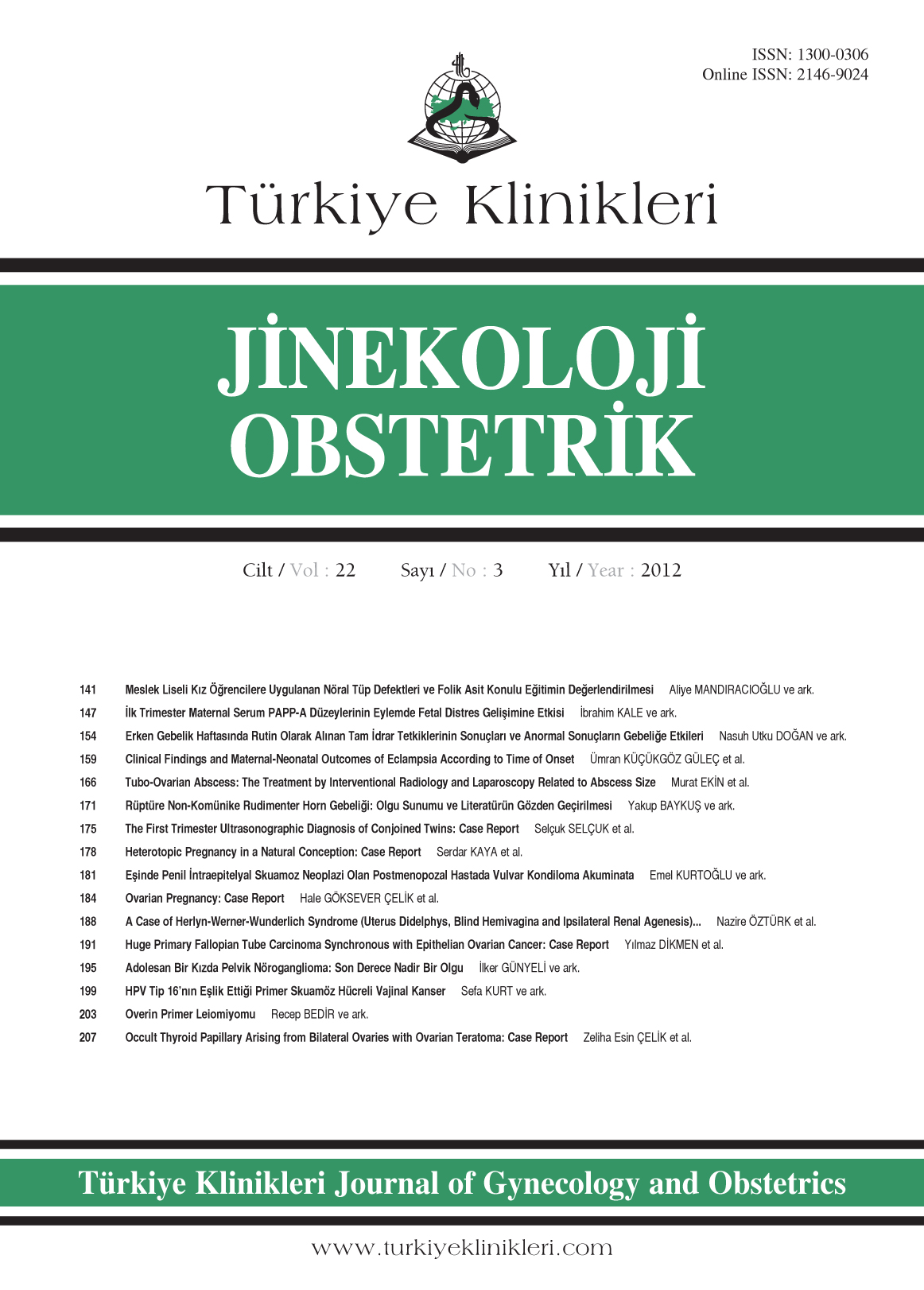Open Access
Peer Reviewed
ORIGINAL RESEARCH
1650 Viewed1438 Downloaded
Tubo-Ovarian Abscess: The Treatment by Interventional Radiology and Laparoscopy Related to Abscess Size
Tubo-Ovaryan Apse Boyutuna Göre Girişimsel Radyoloji ve Laparoskopik Tedavisi
Turkiye Klinikleri J Gynecol Obst. 2012;22(3):166-70
Article Language: EN
Copyright Ⓒ 2020 by Türkiye Klinikleri. This is an open access article under the CC BY-NC-ND license (http://creativecommons.org/licenses/by-nc-nd/4.0/)
ABSTRACT
Objective: To determine the feasibility of the treatment of tubo-ovarian abscess by interventional radiology and laparoscopy related to abscess size. Material and Methods: We collected data from 43 patients admitted with the diagnosis of tubo-ovarian abscess from January 1, 2008 to January 1, 2011. Three abscess groups were created according to size as Group I: ≤4 cm (n=12), Group II 5-8 cm (n=23) and Group III: >8 cm (n=8). Symptoms and signs on admission, findings of laboratory testing and diagnosting imaging, treatment modalities and the duration of the hospitalization were recorded. The feasibility of the interventional radiology and the laparoscopy and conversion to laparatomy in the treatment groups were analysed. Results: Four of the patients were treated only by antibiotics and anti-inflammatory agents. Two of the patients in group I, five of the patients in group II and four of the patients in group III were managed by transvaginal or transabdominal catheter drainage under the guidance of ultrasonography or tomography respectively. Four of the patients in group I and seven of the patients in group II were treated with laparoscopy. Laparoscopy was failed in 6 out of 17 patients whom were converted to laparotomy. The only reported complication was a bowel injury in one of the cases at laparotomy. Conclusion: Treatment of tubo-ovarian abscess by drainage under the guidance of interventional radiology should be encouraged. Laparoscopy may be a surgical management option in experienced clinics in patients with abscess size <8 cm.
Objective: To determine the feasibility of the treatment of tubo-ovarian abscess by interventional radiology and laparoscopy related to abscess size. Material and Methods: We collected data from 43 patients admitted with the diagnosis of tubo-ovarian abscess from January 1, 2008 to January 1, 2011. Three abscess groups were created according to size as Group I: ≤4 cm (n=12), Group II 5-8 cm (n=23) and Group III: >8 cm (n=8). Symptoms and signs on admission, findings of laboratory testing and diagnosting imaging, treatment modalities and the duration of the hospitalization were recorded. The feasibility of the interventional radiology and the laparoscopy and conversion to laparatomy in the treatment groups were analysed. Results: Four of the patients were treated only by antibiotics and anti-inflammatory agents. Two of the patients in group I, five of the patients in group II and four of the patients in group III were managed by transvaginal or transabdominal catheter drainage under the guidance of ultrasonography or tomography respectively. Four of the patients in group I and seven of the patients in group II were treated with laparoscopy. Laparoscopy was failed in 6 out of 17 patients whom were converted to laparotomy. The only reported complication was a bowel injury in one of the cases at laparotomy. Conclusion: Treatment of tubo-ovarian abscess by drainage under the guidance of interventional radiology should be encouraged. Laparoscopy may be a surgical management option in experienced clinics in patients with abscess size <8 cm.
ÖZET
Amaç: Abse boyutuna göre girişimsel radyoloji ve laparoskopik tedavi uygulanabilme başarısın değerlendirilmesi. Gereç ve Yöntemler: 1 Ocak 2008-1 Ocak 2011 tarihleri arasında tubo-ovaryan apse tanısı ile tedavi edilen 43 hastaya ait kayıtlar incelendi. Abse boyutuna göre üç grup oluşturuldu. Grup I: ≤4 cm (n=12), Grup II 5-8 cm (n=23) ve Grup III: >8 cm (n=8). Semptomlar ve laboratuvar bulguları, radyodiagnostik görüntüleme bulguları, tedavi yöntemleri ve hastanede kalış süreleri kaydedildi. Girişimsel radyoloji ve laparoskopik tedavilerin etkinliği ve laparatomiye dönen olgular gruplar arasında değerlendirildi. Bulgular: Hastalardan dördü sadece antibiyoterapi ve anti-inflamatuarlar ile tedavi edildi. Grup I'de iki, grup II'de beş ve grup III'te dört hasta ultrasonografi veya tomografi eşliğinde transabdominal veya transvajinal kateter drenajı ile tedavi edildi. Grup I'de dört ve grup II'de yedi hasta laparoskopik olarak opere edildi. 17 hastadan 6'sında laparoskopi batın içi yaygın yapışıklıklar nedeniyle başarısız oldu ve laparatomiye dönüldü. Laparatomi esnasında bir olguda barsak yaralanması tek komplikasyon olarak bildirildi. Sonuç: Tubo-ovaryan apselerin girişimsel radyoloji kılavuzluğu altında drenajı cesaretlendirilmelidir. Deneyimli kliniklerde ve apse boyutu <8 cm olgularda cerrahi tedavide laparoskopik yaklaşım tercih edilebilir.
Amaç: Abse boyutuna göre girişimsel radyoloji ve laparoskopik tedavi uygulanabilme başarısın değerlendirilmesi. Gereç ve Yöntemler: 1 Ocak 2008-1 Ocak 2011 tarihleri arasında tubo-ovaryan apse tanısı ile tedavi edilen 43 hastaya ait kayıtlar incelendi. Abse boyutuna göre üç grup oluşturuldu. Grup I: ≤4 cm (n=12), Grup II 5-8 cm (n=23) ve Grup III: >8 cm (n=8). Semptomlar ve laboratuvar bulguları, radyodiagnostik görüntüleme bulguları, tedavi yöntemleri ve hastanede kalış süreleri kaydedildi. Girişimsel radyoloji ve laparoskopik tedavilerin etkinliği ve laparatomiye dönen olgular gruplar arasında değerlendirildi. Bulgular: Hastalardan dördü sadece antibiyoterapi ve anti-inflamatuarlar ile tedavi edildi. Grup I'de iki, grup II'de beş ve grup III'te dört hasta ultrasonografi veya tomografi eşliğinde transabdominal veya transvajinal kateter drenajı ile tedavi edildi. Grup I'de dört ve grup II'de yedi hasta laparoskopik olarak opere edildi. 17 hastadan 6'sında laparoskopi batın içi yaygın yapışıklıklar nedeniyle başarısız oldu ve laparatomiye dönüldü. Laparatomi esnasında bir olguda barsak yaralanması tek komplikasyon olarak bildirildi. Sonuç: Tubo-ovaryan apselerin girişimsel radyoloji kılavuzluğu altında drenajı cesaretlendirilmelidir. Deneyimli kliniklerde ve apse boyutu <8 cm olgularda cerrahi tedavide laparoskopik yaklaşım tercih edilebilir.
MENU
POPULAR ARTICLES
MOST DOWNLOADED ARTICLES





This journal is licensed under a Creative Commons Attribution-NonCommercial-NoDerivatives 4.0 International License.











